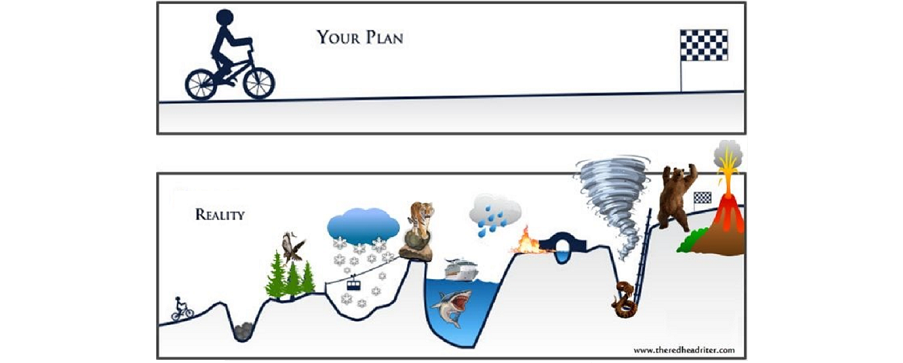Some of you might be familiar with the illustration above (Image Source); the concept presents a person’s path to success and how one sees it, compared to the reality of reaching the goal when persevering. This is the mindset we should take in setting metrics for brand awareness KPIs. We know we can reach our goals, but the path might not always go as planned. And that is OK; as mentioned in the 2nd layer of this framework, they should be used as a compass to where we want to go.
So, what to track on our journey toward the objectives?
As we all know, the “I” in KPI stands for “indicator”, and that’s how we need to treat it. It serves as a benchmark that indicates we are getting closer to our desired goal. We may have an original plan to achieve the KPI, but in reality we often need to adjust and change our approach, but the milestone remains the same.
Consider the analogy of a parent who wants their child to master the multiplication table. Recognizing and understanding each multiplication set is a critical milestone that indicates the child’s progress. Although the method of learning each set may vary, the depth with which each set is mastered shows how close the child is to the overall goal.
Therefore, it is important to set the right KPIs to understand what metrics you need to measure to move in the right direction.
Base your brand awareness KPIs on the objectives.
The KPI should resonate with the objective previously detailed in the second layer. While the KPI might not match the objective right away—for example, if you’re aiming for a 50% volume increase, your KPI for the first month might be set at a 15% increase—it should clearly steer you in that direction.
When setting KPIs, consider these three straightforward guidelines:
- Ensure the KPI aligns with the monthly budget increase.
- If the objective is quantifiable, employ it as a KPI.
- If it’s not quantifiable, establish a measurable metric (this might be as simple as a go/no-go response) to utilize as a KPI.
- Wondering about the appropriate timeframe to achieve your objective? It’s OK if you set a period that feels like you’re gauging which way the wind is blowing, but it’s essential to establish some perspective. Remember to refine this as you progress.
Brand Awareness KPI examples.
We’ll use Jupiter's B2B tech leader company, in the HR industry, with 150 paying customers reached through networking and organic demand, facing a scaling challenge. example to implement this part of the framework:
First, let’s calculate the average monthly budget increase for the campaign:
- Average budget for the past three months: $10K.
- New monthly average: $25K.
- Result: 250% budget increase.
For all the brand awareness KPIs we’ll define for this activity, a 250% increase should be the high bar.
Campaign Objective 1:
Increase relevant traffic (HR personas) to the digital assets from 7K visitors to 10.5K visitors, representing a 50% increase.
Measurability: The objective is specific and measurable so that the KPI metric can mirror this directly.
Timeframe for achieving the Objective: Given that this is the first brand awareness campaign, the intended increase is ambitious yet attainable. We project a timeline of three months to meet this goal.
#1 KPI Breakdown:
- Achieve a 10% increase in relevant traffic to the digital assets in the first month.
- Target a 20% increase in the second month.
- 50% increase by the end of the third month.
Campaign Objective 2:
Be a recognized brand by claiming from 400 brand searches monthly and starting to be mentioned on social media platforms.
Measurability: It is a measurable objective (tracked with Google Search Console and the social tools mentioned), but accurate numbers must be used.
Timeframe for achieving the Objective: Users will need time to get comfortable with the idea. We anticipate a significant increase in brand traffic demand over at least five months.
#2 KPI Breakdown:
- Reach 1,000 (250% of 400) monthly brand searches in five months.
- Achieve consistent mentions on social media, with a goal of more than five mentions per month within three months.
Campaign Objective 3:
A 30% increase in monthly marketing qualified leads (MQL). The current monthly average is 10.
Measurability: Yes. We can set it as the objective for the same reasons as #1.
Timeframe for achieving the Objective: 5 Months, for the same reason as #2.
#3 KPI – Aim to achieve 75 monthly MQLs (which is 250% of 30) over a span of 5 months with the following breakdown:
- First month: 30 (stagnant).
- Second month: 35.
- Third month: 40.
- Fourth month: 40.
- Fifth month: 45.
Campaign Objective 4:
Identify the most resonated message with HR, which will set the ground for the next campaign.
Measurability: A statistically significant winning message for the metric CTR multiplied by the conversion rate. An appropriate tracking structure (discussed in the next section) should be set.
Timeframe for achieving the Objective: Three months to gain enough data.
#4 KPI: Do we have a significant winning message? Yes / No – All messages perform the same.
Brand Awareness Metrics
Once our KPIs are defined, it becomes clearer which metrics reflect their status. These metrics, vital for brand awareness, should be prominently tracked on our dashboard. For instance, the metrics for Jupiter’s KPIs are:
The metric for the 1st KPI:
- % change from the previous period.
The metrics for the 2nd KPI:
- Total impressions for brand searches.
- Number of social mentions.
The metrics for the 3rd KPI:
- Total MQLs across all channels.
- % change in MQLs from the previous period.
The metric for the 4th KPI:
- CTR multiplied by conversion rate at the ad level.
The idea is to construct the framework for the long run, so don’t worry about setting only one KPI and metric at first. Try to feel the sense of how to use it as a compass for the bigger picture.
And now, after we have KPIs set, the last but not least part of the framework comes into action: how will we track and measure those KPIs?
 Linkedin
Linkedin
 Facebook
Facebook



